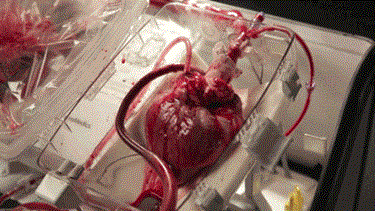The Beat Goes On: Organ Transport Device Keeps Heart Pumping

Scientists are rethinking conventional methods of shipping donated organs on ice. New technology developed by TransMedics, a U.S.-based biotech company, can keep a human heart beating until it arrives in the operating room for transplant. Scientists say that organs transported this way are more viable and could increase the number of transplantable hearts by 15-30 percent, saving the lives of more patients waiting for a new heart.
After a “circulatory death,” the heart stops beating and the tissue is no longer oxygenated. Heart muscle deteriorates quickly at room temperature, and these hearts are no longer suitable for donation. Current methods of organ harvesting cool the body of a brain-dead donor whose heart is still functioning. Once the heart stops moving, it is cut out of the body and transported at 4 degrees Celsius to the waiting recipient.
Cold transport has been the norm in transplant science since its inception, but now researchers are wondering if warm transport might be better. According to MIT Technology Review, research teams from around the globe are working on warm perfusion systems, machines that can keep organs alive until they’re ready for transplant.
Korkut Uygun, transplant surgeon and founder of Organ Solution, told MIT Technology Review, “Cold is the old thing, and warm is the new thing. Warm is the way to go with metabolically active tissue.”
Systems in development at Organ Solution as well as similar companies — Organox in Oxford and Organ Assist in the Netherlands — are perfecting these warm transport systems for kidneys and livers, but could these same ideas be applied to heart transplants? A research team at TransMedics says “yes.”
Called “heart in a box” by developers, the TransMedics’ Organ Care System is a sterile box that houses the donor heart and keeps it oxygenated and nourished with continuously circulating blood, fed into the heart through clamped-on tubing. Thus the donor heart keeps pumping while being transported.
Though the system is pending approval in the United States, surgical teams in the U.K. and Australia have already used the system and have reported success. Last April, The Lancet published clinical data from a series of heart transplants using donor hearts from deceased circulatory death (DCD) patients, which were lauded as a medical breakthrough that significantly broadens the pool of eligible donor hearts.
“The ability to safely transplant a donor heart from DCD donors could be a paradigm shift to potentially increase the pool of viable donor hearts to help more patients suffering from end-stage heart failure,” said Waleed Hassanein, president and CEO of TransMedics, in a press release.
The Cleveland Clinic estimated that 3,000 U.S. patients are waiting for a heart each year, but only 2,000 receive a transplant due to the paucity of donor hearts. Experts cited by MIT estimate that the number of available hearts could increase by 15-30 percent if the TransMedics device is widely implemented in the U.S., but some fear the $250,000 price tag could be prohibitive for many hospitals.
Stephen Large, a U.K. transplant surgeon who has used the TransMedics system eight times, told MIT Technology Review, “The device is vital. The heart gets an absolutely essential infusion of blood to restore its energy.”
